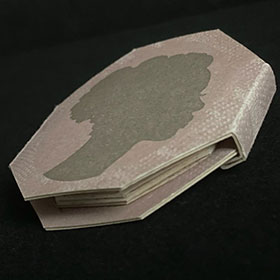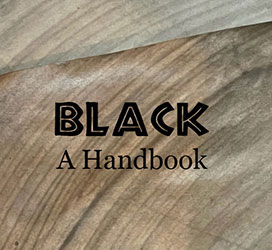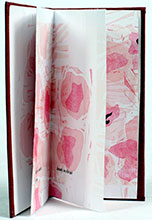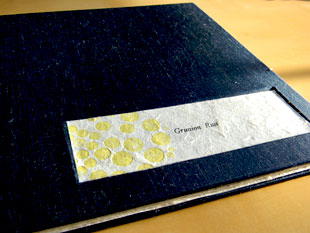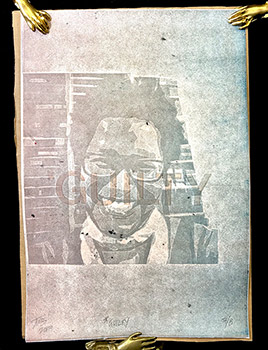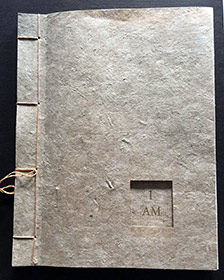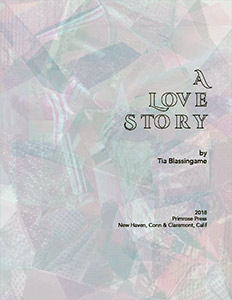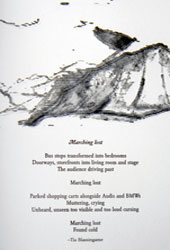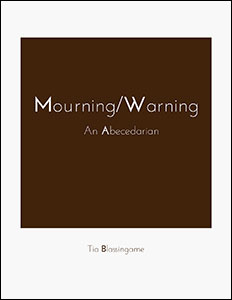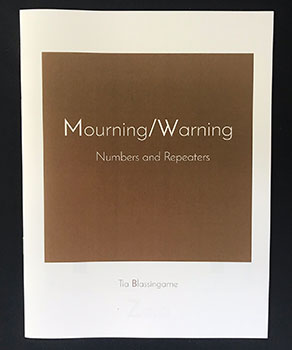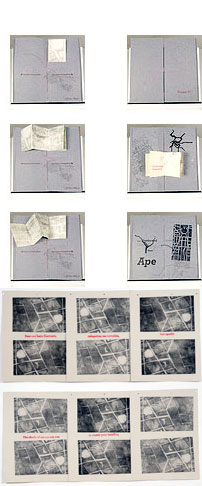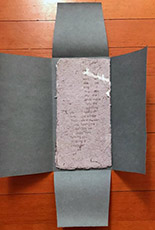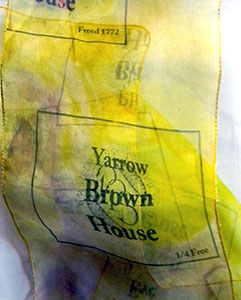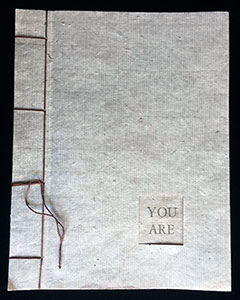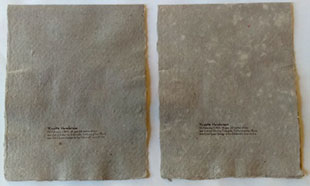
Tia Blassingame
~ California |
Share this page: |
|
 |
Tia Blassingame: “I utilize printmaking in the book form to address issues of race and racism in the United States. Employing a mixture of poetry, typography, printmaking and book arts techniques like relief printing, etching, screenprinting, lithography, letterpress printing, hand papermaking and bookbinding, I examine African American architectural, spatial and cultural history, racial prejudices and perception. As many of my pieces deal with historical racism, I employ period typefaces to create a look and ambiance that transports the viewer to the appropriate era. Because of its tactile nature and impression on the page, letterpress printing invites the viewer to connect immediately and then dissect the text and images slowly. “Disturbing images and histories rendered using wooden or metal letters or an etching plate can be atmospheric and intriguing. Instead of repelling the viewer, artists’ books can allow for a nuanced discussion on issues of race to unfold with each page turn. The reader/viewer can locate themselves within the book as they create their own path to view and connect deeply with the book, its text and prints, history itself.” |
|
'Pause 2” x 2” x .25” octagonal accordion inside a 2.5” x 2.5” locket style container with AI-generated cover image. Printed offset lithography at the Borowsky Center for Publication arts by Erica Honson. Letterpress printed and laser cut in the Albert M. Greenfield Makerspace at the University of the Arts in Philadelphia. Funded by the von Hess Visiting Artists Program. Printed on Somerset paper. Signed and numbered by Blassingame. Tia Blassingame: “With its three-color, offset printed imagery and metallic, letterpress-printed text, ‘Pause consists of the octagonal accordion text block, which is held in a locket-style container with a printed cover. With its letterpress-printed, AI-generated cameo, the offset-printed and laser-cut container features a letterpress-printed, script-style dedication and colophon reminiscent of jewelry engraving. For this project, Blassingame selected a small group of Black women to complete a questionnaire about their awareness of, feelings and memories related to menopause. In the laser-cut, accordion text block, the quoted and excerpted responses were letterpress printed in a blackish-gold ink color in Bitter typeface, which plays upon the stereotype of the bitter or angry Black woman. Serving as the offset-printed backgrounds, scanned materials represent intimacy and vulnerability, softness and strength. ‘Pause is meant to celebrate and extend grace to Black women on their menopause journey, and normalize the discussion of menopause and changes to women’s bodies. |
||
| Primrose Press Out of Print Title: | ||
Black: A Handbook 5.4 x 8.4"; 12 unnumbered folded sheets. Paste paper dyed with persimmon, ash, iron oxide, and indigo by the artist. Digital printing. Tribeca and Optima typefaces. In 26 x 18 x 4 cm lidded wood box. Original poetry written by Tia Blassingame over the last thirty -five years. Each poem is printed on a separate bifoliate paste paper sheet. Signed and numbered by the artist. A companion piece to “Negroes: A Handbook” (2015), “Colored: A Handbook” (2020), and “African American: A Handbook”, “Black: A Handbook” continues the artist’s discussion of race while exploring paper transformation - sifting the texture, surface, color, presence of a simple piece of paper. Colophon: “Despite pandemic exhaustion and varied stressors or maybe because of them, making this edition was strangely calming. This handbook was inspired by artworks, my family, nature, but above all by the strength, perseverance, audacious artistry and unparalleled creativity, dignity, humanity and journey of a people who push forward against all efforts to the contrary.” “Black: A Handbook” consists of ten poems printed on paste paper sheets, each folded. Each poem is titled beginning with “Chapter xx”. The first Chapter “HUMAN’ opens to a design of browns that imagines tendons streaking across the page reflecting the words of the poem - “I’m convinced I AM HUMAN. Nothing you can say or do will sway me or erode my conviction, “. The third chapter “POISON OASIS” has words “Doused in curling oil .. fears are scooped into the bumpy pockets” with a paste design of arches and blobs that resemble bumps and curling. And so, the poetry and imagery go through each chapter – each reflecting the other in simplicity and soulful emotion. |
||
| Commonplace By Tia Blassingame [Silver Spring, Maryland]: Primrose Press, 2011. Edition of 7. 3.25 x 7.25" closed, extends to 9"; 8 pages. Flutter book construction. Sumi-e ink and linoleum block prints. Printed on Japanese washi paper. Handbound in cherry red Japanese cloth over boards. Title label on front board handset letterpress on Primrose Press handmade paper. Signed and numbered by the artist. Tia Blassingame: "Commonplace is a flutter book. It consists of original poetry letterpress printed with sumi-e ink and linoleum block prints that emulate cherry blossoms flowing in the breeze." (Out of Print) |
||
Grunion Run |
||
Guilty 7" x 10.25" single sheet. Letterpress. Pressure printing. Backed with kozo paper. Signed and numbered by the artist. Tia Blassingame: "These are concept prints for a new artist's book that I am working on [I AM]. They stand alone, but like everything I do they helped to move the book idea forward." Tia Blassingame, Entropy Interview December 18, 2017, in answer to the question "Where are you focusing your next experience?": "I’m very interested in the relationship between black and white in terms of who is considered innocent, criminal. As a nation, we continue this long history of re-victimization of black victims and their loved ones, and of a justice system that does not provide justice if the crime is committed by a white American against a black American. Even in our popular culture we joke about this. We accept this as tragic, but almost inevitable. Though both are constructs, blackness does not exist without whiteness. Whiteness cannot exist without blackness. It’s fascinating how that relationship plays out like the biggest threat to white supremacy is just being, existing in this skin." Tia Blassingame, next project I AM: "I AM is one book or two depending upon how you view their relationship. Using old family photographs and portraits, my image at various ages represents various recent victims of police brutality. The idea of a duality me, you. Victim, perpetrator was added after it was revealed that a juror in the Terence Crutcher case had voted not guilty because he was tired and hungry, and just wanted deliberations to be over so he could eat. "(On September 16, 2016, Terence Crutcher, a 40-year-old black man, was fatally shot by white police officer Betty Shelby in Tulsa, Oklahoma. He was unarmed during the encounter, in which he was standing near his vehicle in the middle of a street.)" |
||
I AM 9.5 x 12"; 38 pages (free end leaf, title leaf, introduction leaf, separation leaf, 12 image leaves, colophon leaf). Images and title printed on recto only. Printed on kozo and lokta papers. Pressure printing. Handset letterpress printing. Stab binding in paper covers. Signed and numbered on the colophon. Tia Blassingame: "The artist places herself as a stand-in for African American victims of police brutality, violence, and humiliation. Unlike the victims and their families, the artist controls which images are shared and how. She can delete information: background, people. She can alter color, scale, orientation. Accompanying letterpress text serves as captions and shows incredible racial profiling and post-mortem media portrayals of African American victims. Personal and family photographs as well as those that the artist shared on social media were digitally manipulated, then hand-cut, and assembled as paper matrices. "With each photograph and subsequent turn of the page, I AM represents both the abrupt end of a life. A baby does not become the toddler standing unsteady with her hand patting an ottoman as her father watches television in the background. The toddler does not spend her tenth summer swimming in the pool and making friends at camp. And so on. Being black means I am a baby. I am a child. I am a teenager. I am an adult. I am a woman. I am a person. Too often suspect." |
||
A Love Story 8.5 x 11"; 30 pages including covers. Color digital print. Printed in Avenir, Cinzel, and Cinzel Decorative typefaces. Background images of artist's collages. Saddle stich binding (stapled). Signed and numbered by the artist. Tia Blassingame: "Conceived of at the Paper & Book Intensive (PBI) at Oxbow School of Art in Saugatuck, Michigan May 2017, the book is about love of craft and the book arts field. Related to making artists' books with a social justice focus, it presents the artist's creative process including printing, editioning, and presenting. Between criss crossing the country, the artist employed the collage making process to de-stress while maintaining focus on simultaneous projects focused on issues of race and racism." Colophon: "For just over a year, I had been working on a project about love, or trying to at least. Then I accepted that I was not in love with any person. there was no man with whom I wanted to connect, but there was love of craft, of practice, of field. with that realization, this project quickly came together. I hope this book speaks more eloquently that I on my process of creating an artist's book from conception to the last stitch and beyond. "Many magazines and newsletters were torn up to create a dozen collages. The collage-making process was used as a way to de-stress and simultaneously maintain progress and focus on this and other projects that dealt with issues of race and racism. Flown between the two coasts repeatedly, many notebooks and hotel writing pads as well as a laptop are filled with notes, drafts, and diagrams for this book." |
||
Marching Lost 8.5 x 11" single sheet. Letterpress printed in Garamond BE typeface on Moab Entrada paper. Tia Blassingame: "This broadside combines a sketch and poem to address the invisibility of the homeless and their displacement by political protests." Bus stops transformed into bedrooms March Lost Parked shopping carts alongside Audis and BMWs Marching lost (SOLD/Out of Print) |
||
Mourning/Warning 8.5 x 11"; 32 pages including wrappers. Digitally printed in Josefin Sans typeface. Saddle stitch binding. Signed and numbered. Tia Blassingame: "Stripping the maritime alphabet of its primary colors and replacing them with muted browns and blacks, Mourning/Warning highlights the relationship of Americans of the African diaspora to water, maritime trade, and the need for an alternate means of communication in times of emergency and duress. How do you send a warning call that hatred comes constantly in waves? "M/W serves as a method of honoring, mourning, and remembering the slain and wronged as well as teaching our children and ourselves to be vigilant and wary in hostile terrain, where your skin color makes you an easy target." Proceeds will be donated to non-profits including NAACP Legal Defense Fund, Southern Poverty Law Center, and Innocence Project. This is a simple but shrewdly designed presentation of disturbing information. It transforms mere documentation into a lament and call for change. From the Alfa flag (in its muted version representing Marissa Alexander, sentenced for firing a warning shot at her husband when he attacked her) to the Zulu flag (representing Ousmane Zongo, unarmed but killed by a NYC officer during a 2003 warehouse raid), this list of mostly unremembered casualties represents part of the everyday reality for people of color. |
||
Mourning/Warning 2 8.5 x 11"; 24 pages including wrappers. Digitally printed in Josefin Sans typeface. Saddle stitch (stapled) binding. Signed and numbered by the artist. Tia Blassingame: "This set of numerical and repeater, or substitute, maritime flags compliments the alternative alphabetical flags featured in Mourning/Warning: An Abecedarian. The repeaters make character duplication possible and can make historical and contemporary patterns of suffering, grief, humiliation painfully apparent." Colophon: "Stripping the maritime alphabet of its primary colors and replacing them with muted browns and blacks, Mourning/Warning highlights the relationship of Americans of the African diaspora to water, maritime trade, and the need for an alternate means of communication in times of emergency and duress. How do you send a warning call that hatred comes constantly in waves? "M/W serves as a method of honoring, mourning, and remembering the slain and wronged as well as teaching our children and ourselves to be vigilant and wary in hostile terrain, where your skin color makes you an easy target "The names of victims of police brutality, unsolved murders, violence motivated by homophobia and transphobia with missing individuals like Phoenix Coldon fill this edition. John Robinson represents the victims whose murders go unsolved and seemingly forgotten for decades. For too many, justice remains distant." |
||
Past Present: DC Set of two books and two wall hangings. Two volumes (Past DC; Present DC): 9 x 17 x 1.75"; 22 pages, 20 pages. Text was printed with handset and polymer letterpress on handmade paper made of the artist's clothing and Rives paper. Typefaces employed included Archer, Century Schoolbook, Helvetica, Janson, Old Claude, Optima, and Univers. Poster TGothic and Devinne wood typefaces formerly of the Government Printing Office were also used. Laid in clamshell box covered in matching handmade paper with cloth spine. Two wall hangings: 30 x 132". Tia Blassingame, Past DC Colophon: "Surveying historical segregation in the District of Columbia, Past Present: DC posits the idea that we are as segregated today as yesterday. We are separated by the same fears, hat, ignorance, and silence. As the nation's capital and as an American city, D.C. is layered with sites of humiliation, trauma, and racial violence that do not need to be within the city's physical borders to become part of the urban grid and \psyche. Conveyors of information, outrage, and sentiment within African American communities across the nation. "In Past Present: DC, text from historic Jim Crow signs of the DC metro area and other American cities aware printed with handset wood and metal type. Text was position to allow the page to act as a reconstituted sign. Listings of area establishments that accepted African American customers came from mid-twentieth century issues of The Negro Motorists Green Book and Travelguide. "The lyrics of popular American songs portray the journey of African American and white residents across the city where The Star-Spangled Banner seems symbolic of independence, songs of significance to the African American community and of prominence in the Civil Rights movement represent the African American citizen's restricted journey. From 'Swing Low, Sweet Chariot' by Wallis Willis to James Weldon Johnson's 'Lift Every Voice and Sing' to 'A Change is Gonna' Come' written by Sam Cooke, the songs change in step with the African American citizen's struggles for equity, enfranchisement, and recognition as an American and a human being' as the white citizen's position or primacy as an American has never been in doubt, the representative song 'The Star Spangled Banner' remains static." Tia Blassingame, Present DC Colophon: "Text from popular bumper stickers, the news cycle, and contemporary political rhetoric replace historic Jim Crow era signs. Mirroring the rhetoric and prejudices of the past: African Americans as primates, promiscuous, and un-American, terms overrun the page and compete for attention, page spreads turn into billboards or monitors. "A shift in residents' journeys presents as a reversal of lyric placement. While The Star Spangled Banner still represents the white resident, original text running fluidly across the book picks up where Negro spiritual and popular song lyrics left off in Past Present: DC." |
||
Settled (prints) 6 x 12"; 3 single sheets letterpress printed on both sides. Paper handmade from artist's clothing. Laid in letterfold wrapper with titles on front cover. Initialed and dated by artist on the wrapper. Three prints from the artist's book project "Settled: African American Sediment, or Constant Middle Passage". Each print features a different slain African American citizen: Trayvon Martin (a 17-year-old from Miami Gardens, Florida, fatally shot by a neighborhood watch volunteer in 2012); Relisha Rudd (an 8-year-old girl who vanished from a D.C. homeless shelter in 2014); and Eric Garner (a 44-year-old male who died after a NYPD officer put him in a chokehold.) Original concrete poetry printed on both sides while spotlighting the situations of these individuals. |
||
Slavery's Historic House Signs: in harvest II 5.5 x 31" scarf of organza. Screen printed. Design Indaba Conference 2015, Tia Blassingame on the texture of racism in the United States: "When Tia Blassingame arrived in Rhode Island she began collecting autumn leaves and imaging the many slaves who might have seen the leaves from those same trees changing colour many years ago. Feeling moved by the thought that these leaves were perhaps not all she had in common with the slaves of early modern America, Blassingame began a project that would engage readers in a conversation about race through playing with their senses. "Blassingame screen-printed receipts and accounts from slave ships onto the leaves. “Brown inks that represented the colours of the autumn leaves and the skin colour of the slaves,” says Blassingame. "She then made a golden headscarf that was printed with images of these leaves and words, to investigate how the wearer might carry herself, knowing that she was wearing words from a slave receipt." Tia Blassingame: "Every city and history holds invisible populations. Walking past the historic homes along Benefit Street in Providence, Rhode Island, one passes house markers that distinguish a population of white males and their achievements. The scarf-artists' book considers the African slaves that resided and worked in the homes of the Brown and Hopkins families. While their owners are remembered as the founders of Brown University, businessmen or as the state Governor, signer of the Declaration of Independence, the slaves have been forgotten. This piece is part of a larger project, that began as a way of cataloguing names and facts as I conducted research on the role of Rhode Island in the Atlantic slave trade at the John Carter Brown Library of Brown University. "Each fabric piece represents the content of an artists' book, a journey down a street and through history and family trees. How it is bound, covered, paced, draped is up to you, the reader/wearer. Also up to you is how, if at all the reader/viewers that you will encounter will be able access or read this artists' book that you activate by how you arrange and wear it." For example, the notation Yarrow Brown House ¼ free represents Yarrow who was a slave owned by the four Brown Brothers of Rhode Island. When the brother Moses Brown freed his slaves Yarrow then was only a quarter free; that is, ¼ free or ¾ slave. Link to video "Tia Blassingame on the texture of racism in the United States" |
||
YOU ARE Tia Blassingame: "In 'YOU ARE', the artist places herself as a stand-in to explore black womanhood through the standard descriptors of white womanhood. Starting with Hallmark movie descriptions, the artist noted the adjectives used to describe the primarily white protagonists of romantic films. The assembled words are seldom used to describe African American women and girls. The artist created a second list of terms that she felt were not considered realistic descriptions of them due to prejudice, hate, fear, ignorance. Black girls, and all black children, are rarely viewed as innocent or childlike, but as disjointed shadows or threats. Black women are seldom viewed as beautiful or acceptable romantic protagonists as evidence by the dearth of such in Hallmark romance movies. "Paired with pressure printed artist self-portraits that shift in terms of fragmentation and obfuscation, the handset letterpress text emerges as a fractured list of affirmations for black girls and women. Similar to the 'I AM' artist's book (2018), the artist controls how and how much photographic detail is shown. She can delete information: backgrounds, people. She can alter color, scale, orientation. Personal and family photographs as well as those that the artist shared on social media were digitally manipulated, handcut, and assembled as paper matrices. The accompanying letterpress text serves as captions, which depending upon the reader and who they deem to be 'they' reads as affirmations of black womanhood or re-evaluation of white womanhood as the only ideal in terms of beauty, and human value." |
||
Yuvette's Purse 7 x 9" closed; one opening. Handmade paper. Letterpress printed. Numbered and initialed by the artist. Tia Blassingame: "On February 3, 2015, [Yuvette Henderson] 38 year-old mother of two was shot and killed by Emeryville, California police officers near Extra Space Storage at the Oakland-Emeryville line. "This piece consists of an original concrete poem in the shape of a handbag printed on paper handmade by the artist." |
||
Page last update: 07.16.2024
Home | About Us | Contact Us | New Arrivals | Fine Press & Artists' Books | Broadsides |Resource Books | Order/Inquiry
Copyright © 2021 Vamp & Tramp, Booksellers, LLC. All rights reserved.
